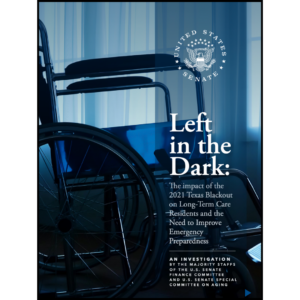Top six ways to manage supply expenses in long-term care
With rising costs and the threat of reduced reimbursements looming, now is the time to evaluate how your facility’s supply expenses are managed. To improve supply chain management and efficiency in the long-term care setting, consider the following six areas of focus: Organization, Setting Goals, Prioritizing, Sourcing, Training, and Technology.
Organization
Does your facility have a centralized or decentralized purchasing structure? Does your facility or company have well-communicated purchasing policies and procedures? Organization is the key to any endeavor, especially in purchasing and managing inventories. Taking action on these two questions will provide instant savings at any facility.
A centralized purchasing structure permits a few authorized buyers to coordinate supply purchases, which not only helps to control spending, but also to exercise tighter controls over inventories and utilize the varied expertise of employees in the procurement process. Also, this structure can help leverage buying power with multiple vendors and/or distributors.
When an organization has a decentralized purchasing structure, department heads are empowered to make buying decisions and are also held more accountable to the end user. One drawback to this structure is that its success in managing supply expense depends greatly on the department head’s negotiating abilities. To address challenges in a decentralized purchasing environment, some facilities have developed formularies, i.e., a set group of vendors or items, for their buyers, along with strict dollar thresholds to help contain costs.
Establishing clear and concise policies and procedures is essential to optimal management of the supply chain. Protocols should be comprehensive policies, outlining everything from who has access and authority to enter a storage room to who is accountable for managing inventories. These procedures should be used to train new employees, with a thorough explanation of how and why the policy structure is relevant and the importance of adhering to the protocols.
Setting goals
In addition to finance or internal audit development goals for the inventory, factors such as cycle counts, inventory stratification, turn rates, inventory valuation, and variance rates should also be at the top of the list for performance evaluation. These tools and measurements are used across multiple industries to help manage inventories. Like the supply purchasing policies, these goals should be shared and embraced by the entire purchasing team.
In today’s world of high gas prices and reduced reimbursements, a goal of saving 10% in each department and incentivizing the department to achieve this objective can positively affect the bottom line.
Prioritizing
Large capital purchases always get—and deserve—extra attention. However, an audit of all expenditures over the course of a year provides a clear picture of the items you must have to operate your facility, as well as what should be inventoried and perhaps shouldn’t. Focusing on priority items and efficiently managing suppliers is essential to the success of an inventory management program.
Prioritizing is also essential for disaster planning. The importance of knowing which items and suppliers are mandatory in a time of need cannot be overstated. Make sure to review your disaster plan with each vendor. Remember, some vendors may have prioritized their products by marking them to go to a hospital before reaching a long-term care facility.
Because healthcare is a 24/7/365 operation, maintaining appropriate inventory levels is a balancing act. It is, of course, necessary to have sufficient inventories and storage space, but some facilities rely on “just in time” suppliers to reduce storage overhead. This can work, but be careful about critical products. If there is a disaster, such as Hurricane Katrina, can your vendor still supply you “just in time”? You should also analyze delivery costs and the cost of ordering and processing invoices versus more inventory/storage to determine if this method could work for you. Cultivate a good relationship with all vendors, but especially those vendors supplying the critical products necessary to operate your facility.
Sourcing
With so many healthcare vendors and new products in the marketplace, it is hard to keep up with product advances and maintain purchasing efficiency. Choosing good direct vendors and food, pharmacy, housekeeping, and medical supply distributors can help. Vendors and distributors should keep you informed of the latest products and services and work with you as a partner to ensure that your operation runs more efficiently.
Whether your facility is a centralized or decentralized operation, policing the number of vendors coming in and out of the facility can be a job in itself. Develop policies such as having all vendors sign in at the front door. Make sure the purchasing department reviews the list daily and have decision makers inform the purchasing department of all vendors they have contact with. New technology such as a single-source ordering system that combines your selected vendors is a very effective tool for maintaining control on spend and vendors, regardless of your purchasing structure. You may also consider implementing a vendor credentialing system to ensure procurement policies are observed.
Almost all facilities use a group purchasing organization (GPO), and some use several. GPOs help by negotiating contracts with vendors and should also serve as an advocate when dealing with the vendor. However, using multiple GPOs can sometimes be counterproductive, especially if constantly checking prices is necessary. It is more efficient from a productivity standpoint to work with just one, or a maximum of two GPOs, to help you find ways to save. That is their job and purpose. GPO pricing should save you up to 10% or more on average if you use several of their contracted vendors.
Training
Once the above considerations have been defined, staff needs to be trained to understand what is expected of them. They should receive regular feedback on their progress, such as in achieving the stated supply management goals. Let the staff see results of their hard work and dedication. Posting turn rates and rewarding an employee who has helped save 10% in a department helps build awareness and commitment.
In the long-term care market, employee turnover rates are high. Training employees—and especially new employees—is time consuming and can be costly. Each department head should therefore be charged with developing a training manual. It will guard against chaos if a key person leaves, and it provides a blueprint for his or her successor. Vendors can also be helpful in training. Ask vendors, including your GPO partner, about staff training that they provide in connection with their products and services.
Technology
The proper selection and application of technology is paramount in helping to obtain savings and efficiency improvements. Involving end users in the selection process is important to ensure widespread adoption of the technology. For instance, if a department head is not computer-literate, an online ordering system may serve as an obstacle to efficiency and productivity rather than an aid. Do not adopt technology for technology’s sake. Be sure that the solution will deliver the results you need. Additionally, make certain that the purchasing technology selected interacts with all departments for the greatest results.
Conclusion
Implementing all of these ideas or a variation of them will undoubtedly save your facility money. Some provide instant savings, while others will take time and effort. The keys are commitment, planning, and persistence, from the top to the bottom of your organization.
John Kautzer is Director, Distribution, Alternate Site & Patient Care Services; and Chet Chandler is Vice-President, Long-Term Care, both at MedAssets, Inc., which consults with healthcare organizations on spend management and revenue cycle improvement. MedAssets Supply Chain Systems recently aligned with the American Association of Homes and Services for the Aging (AAHSA) to form the largest buying group for not-for-profit long-term care organizations.
For further information, visit https://www.medassets.com. To send your comments to the authors and editors, e-mail kautzer0708@iadvanceseniorcare.com.
I Advance Senior Care is the industry-leading source for practical, in-depth, business-building, and resident care information for owners, executives, administrators, and directors of nursing at assisted living communities, skilled nursing facilities, post-acute facilities, and continuing care retirement communities. The I Advance Senior Care editorial team and industry experts provide market analysis, strategic direction, policy commentary, clinical best-practices, business management, and technology breakthroughs.
I Advance Senior Care is part of the Institute for the Advancement of Senior Care and published by Plain-English Health Care.
Related Articles
Topics: Articles , Facility management , Operations











